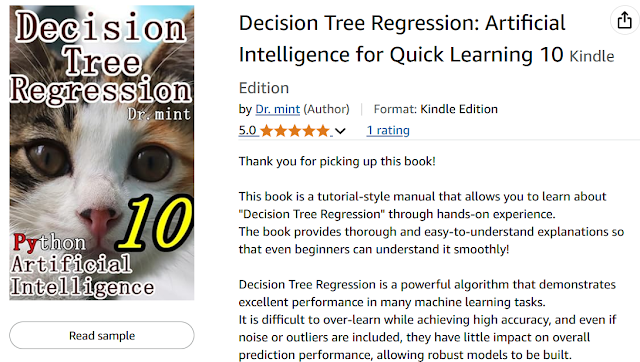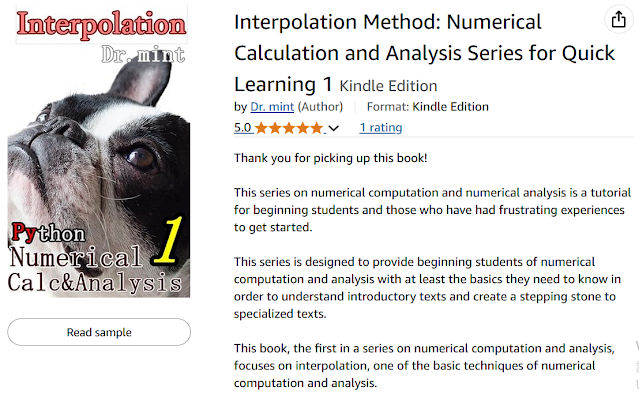Mint Publishing has published the following books.
All of them are easy to understand and carefully explained so that you can understand them from scratch.
The following series are available now.
- Artificial Intelligence Series
- Mathematics Series
- Physics Series
- Image Processing Series
- Numerical Computation and Analysis Series
- Python Series
- R Series
The series is organized in such a way that you can learn from the one you are interested in, or you can start with the first volume of the series in order. By going back and forth between the series, the content is highly synergistic with each other.
Each of the books is listed below.
(For more information about each book, please visit the respective book page.)
Artificial Intelligence Series
[1]. Understanding Perceptrons: A Foundation for Deep Learning
(coming soon)
[2]. Understanding the Improved Perceptron (The Ancestor of Deep Learning)
If you want to learn ADALINE, we recommend this book (access here).
[3]. Understanding Linear Regression from Scratch
If you want to learn linear regression, we recommend this book (access here).
[4]. Understanding Logistic Regression from Scratch
If you want to learn logistic regression, we recommend this book (access here).
[5]. Understanding k-Nearest Neighbors from Scratch
If you want to learn k-Nearest Neighbors (Nearest Neighbor Method), we recommend this book (access here).
[6]. Understanding Multiple Regression from Scratch
If you want to learn multiple regression analysis, we recommend this book (access here).
[7]. Decision Trees A Beginner's Guide
If you want to learn decision trees, we recommend this book (access here).
[8]. Understanding the Bootstrap Method from Scratch
For those who want to learn the bootstrap method, we recommend this book (access here).
[9]. Understanding Random Forests from Scratch
If you want to learn Random Forest, we recommend this book (access here).
[10]. Understanding Decision Tree Regression from Scratch
For those of you who want to learn decision tree regression, we recommend this book (access here).
[11]. Understanding Support Vector Machines from Scratch
If you want to learn Support Vector Machines, we recommend this book (click here).
[12]. Understanding AdaBoost from Scratch
If you want to learn AdaBoost, we recommend this book (access here).
[13]. Understanding k-Nearest Neighbor Regression from Scratch
If you’re interested in learning k-Nearest Neighbor Regression, we recommend this book (access here).
[14]. Understanding Random Forest Regression from Scratch
If you are interested in learning Random Forest Regression, we recommend this book (access here).
[15]. Understanding Support Vector Regression from Scratch
If you want to learn Support Vector Regression, we recommend this book (access here).
[16]. Understanding Cluster Analysis from Scratch: K-Means Method ①
If you want to learn the k-means method, we recommend this book (click here for access).
[17]. Understanding Principal Component Analysis from Scratch
(coming soon)
[18]. Understanding Data Visualization from Scratch
(coming soon)
[19]. Understanding Descriptive Statistics from Scratch
(coming soon)
[20]. Understanding Probability and Probability Distributions from Scratch
(coming soon)
[21]. Understanding Sample Surveys and Estimation: From Zero to Proficiency
If you want to learn about sample surveys and estimation, we recommend this book (access here).
Mathematics Series
[1]. Understanding Trigonometry from Scratch: Sine, Cosine, and Tangent
If you want to learn trigonometry, we recommend this book (access here).
[2]. Understanding Exponential Functions from Scratch
If you want to learn exponential functions, we recommend this book (click here for access).
[3]. Understanding Logarithmic Functions from Scratch
If you want to learn logarithmic functions, we recommend this book (click here).
[4]. Understanding Reciprocal Functions from Scratch
If you want to learn about reciprocal functions, we recommend this book (click here to access).
[5]. Understanding Differential Equations of Separable Variables from Scratch
If you want to learn about ‘differential equations’ of separable variables, we recommend this book (access here).
[6]. Understanding Hyperbolic Functions from Scratch
If you want to learn about the "differential equations" of hyperbolic functions, we recommend this book (access here).
[7]. Understanding Differential Equations Solved with Variation of Parameters

If you want to learn more about solving differential equations with variation of parameters, we recommend this book (access here).
[8]. Understanding Linear Differential Equations with Constant Coefficients
If you're interested in learning linear differential equations with constant coefficients, we recommend this book (click here).
Physics Series
Image Processing Series
[1]. Environment Building for Image Processing
If you want to learn Image processing, we recommend this book (access here).
[2]. First Steps in Image Processing Basics
If you want to learn Image processing, we recommend this book (access here).
[3]. Image Binarization
If you’re interested in the world of binarization, please refer to the following books! (access here)
[4]. What is Image Representation?
(coming soon)
[5]. What is Image Compression?
If you've become interested in learning about image compression, please refer to the following books as well! (access here)
Numerical Computation and Analysis Series
[1]. Understanding Interpolation from Scratch
If you’re interested in learning interpolation, we recommend this book (click here for access).
[2]. Understanding the Euler Method from Scratch

If you're interested in learning the Euler method, we recommend this book (access here).
[3]. Understanding the Modified Euler Method (Heun's Method) from Scratch
If you want to learn the Modified Euler Method (Heun's Method), we recommend this book (access here).





























コメント
コメントを投稿